Abstract
Schools in Australia have been required to have emergency plans and to conduct fire drills for many years. These plans and drills primarily relate to structural fires, supplemented more recently by lock-down procedures for internal threats and lock outs for external threats. Since bushfires in Victoria in 2009, school authorities in NSW have significantly increased support for schools and school leadership to cope better with natural hazards. The incidence of an aggressive bushfire that broke out in Springwood, NSW, while schools were in session provides an opportunity to assess effective preparation by schools and support from school authorities. Critical to the survival of these schools that were directly threatened by the bushfires were systematic preparation, the examination of worst-case scenarios and full rehearsals to test plans. On the day of the fire, the key element of success was the situational awareness by the leadership teams that supported their decision-making. This was aided by communication to the schools’ communities. This paper outlines the key issues that contributed to an effective response by the schools to this incident.
Introduction
On 17 October 2013, a bushfire ignited near Linksview Avenue in Springwood, NSW, at approximately 1:30 pm. Driven by gusty west-south-westerly winds, it rapidly grew to be the most destructive bushfire seen in Winmalee and Springwood in living memory. More than 650 houses were affected with 194 being completely destroyed. Importantly, no lives were lost (State Coroner’s Court of New South Wales 2018, p.4). The fire directly affected two schools in the area, reaching one and isolating the other. The experience of these two schools provides lessons to examine how schools can survive bushfires.
Preparation for bushfire
The NSW schools sectors have long been aware of the threat of bushfire and have taken measures for protection. In 2009, in the wake of the Victorian Black Saturday fires, the three school sectors (Catholic, government and independent) were notified by the NSW Rural Fire Service (RFS) that schools would be conduits for the transmission of Catastrophic-rated fire weather warnings. Up until that time, schools had no role in bushfire response and no training had been provided to school leaders in relation to these emergencies.
By 2012, the RFS was conducting preseason briefings for the schools sector and stressed that principals had the key responsibility to close or evacuate schools (NSW Rural Fire Service 2012). At that time, the RFS operated within a decentralised structure and briefings were provided to the sector centrally but not communicated out to districts and local brigades. There was no additional support made available to schools to meet the RFS expectations. While the Catholic Education Commission NSW (CECNSW) had no operational role in the conduct of its schools, it was concerned about school principals lacking appropriate training for these types of emergency situations. In cooperation with the local Winmalee brigade, the CECNSW developed a
pilot exercise to give principals the kind of knowledge they would need to respond effectively should an emergency situation arise. The pilot exercise, the ‘Hawkesbury Road Project’, was conducted at the Winmalee Rural Fire Brigade station on 5 March 2013. Three schools participated being St Thomas Aquinas Primary School, St Columba’s College and Wycliffe Christian School.
St Columba’s College is adjacent to the Blue Mountains National Park and is almost entirely surrounded by bush. St Thomas Aquinas School has a similar but lower exposure although its buildings are mostly timber and are more vulnerable to fire. Both schools were conducted by the Diocese of Parramatta which had been proactive with support to the schools because of their vulnerability to bushfire threats. The schools have a common access road off Hawkesbury Road, Springwood and both schools are vulnerable to bushfires, which historically come from the west. Both schools maintain an excellent working relationship with the Winmalee Rural Fire Brigade. While attitudes to natural emergencies can limit willingness to commit to preparation (Paton et al. 2006, Paton, Burgel P & Prio 2008, Prior 2009), both schools were enthusiastic to collaborate.
Based on the training provided through the Hawkesbury Road Project, all schools made plans for what they would do if threatened by a bushfire. The plans included preparation for worst-case scenarios that accounted for the ages of their students and included drills to rehearse actions and test procedures.
A key component of any emergency plan for schools is the information provided to families. In the case of St Columba’s College, bushfire emergency information was in student school diaries and on the school website. St Thomas Aquinas School provided information in newsletters and school handbooks. St Thomas Aquinas School also had two drills during which they used their new hall to muster the children. St Columba’s School had inducted Year 7 students and new staff and had conducted drills including moving the entire school to the Church building on Hawkesbury Road as an evacuation exercise.
Linksview Road fire, 2013
The Linksview Road fire broke out on 17 October 2013 not far from both St Thomas Aquinas and St Columba’s schools. Driven by winds gusting between 30 and 70 km per hour, low humidity and a temperature of 30 degrees, the fire quickly took hold. The first Triple Zero calls were received just after 1:25 pm (State Coroner’s Court of New South Wales 2018, p.30). Units from Fire and Rescue NSW and RFS responded but were unable to extinguish the fire in its early stages. The fire advanced to Hawkesbury Road, adjacent to St Thomas Aquinas School. The fire spotted across the road and into the gullies east of Hawkesbury Road, spreading rapidly and spotting across the Nepean River into Castlereagh about 3:30 pm (see Figure 1).
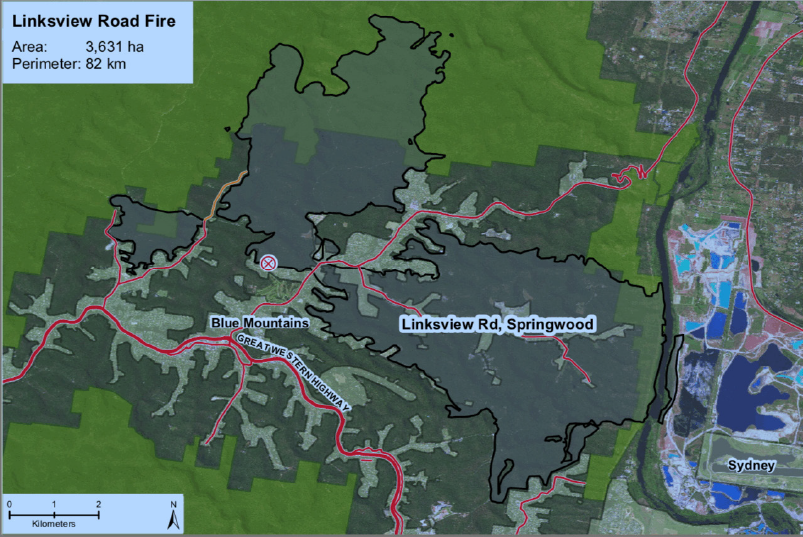
Figure 1: Areas affected by the fire from its point of ignition. The schools are located to the north-west of the point of ignition. Source: www.rfs.nsw.gov.au/__data/assets/pdf_file/0004/53068/Maps-LinksviewRd.pdf
The schools’ responses
St Columba’s College
The acting principal at St Columba’s College became aware of the proximity of the Linksview fire when a student pointed out the smoke column to the south-west towards Springwood. At 1:36 pm, a Triple Zero call was made reporting the fire. St Columba’s College contacted the principal at St Thomas Aquinas School to notify him of the approach of the fire.
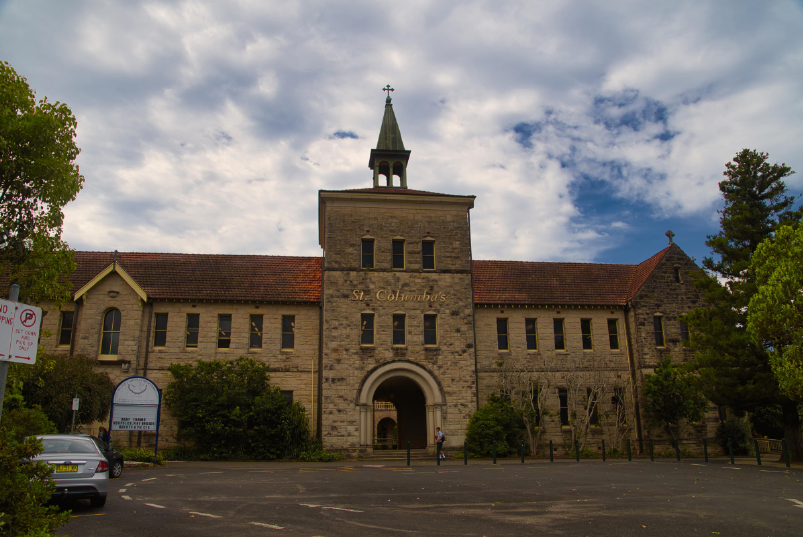
St Columba’s College main stone building looking north. Image: Tony McArthur
At St Columba’s College, the acting principal instructed all students to go to their classrooms and the school went into lockdown and continued scheduled lessons (students doing Higher School Certificate examinations were not disturbed). By 2:30 pm, the fire was visible and had isolated the school from its only access road making an evacuation via that route impossible. While the school was not in immediate danger, power was cut off by the fire within an hour after the lockdown and the school was dependent on mobile phone access for information. The school sent information to parents, although students and staff were already making mobile phone calls, overloading the local network. The school used the Diocese of Parramatta’s Telstra Integrated SMS system to send messages to families to avoid using the local telecommunication towers. In this period, the first fire appliance arrived but it did not stay once it was determined that the school was not under direct threat.
At 3:30 pm, students assembled in the enclosed quadrangle and staff checked class rolls. The students received a briefing on the situation. They were then sent into the main stone building to shelter and students and staff remained at the school. At 6:30 pm, police organised transport to remove almost 1100 people from the college to an evacuation centre at the Springwood Sports Club. Parents were notified of the planned evacuation via SMS at 6:37 pm. The evacuation process was lengthy, finally ending shortly before 8:00 pm. Staff accompanied the students. Marking class rolls at the evacuation centre proved very difficult because of the layout and parents wanting to be reunited with their children. The school did not open again until 28 October.
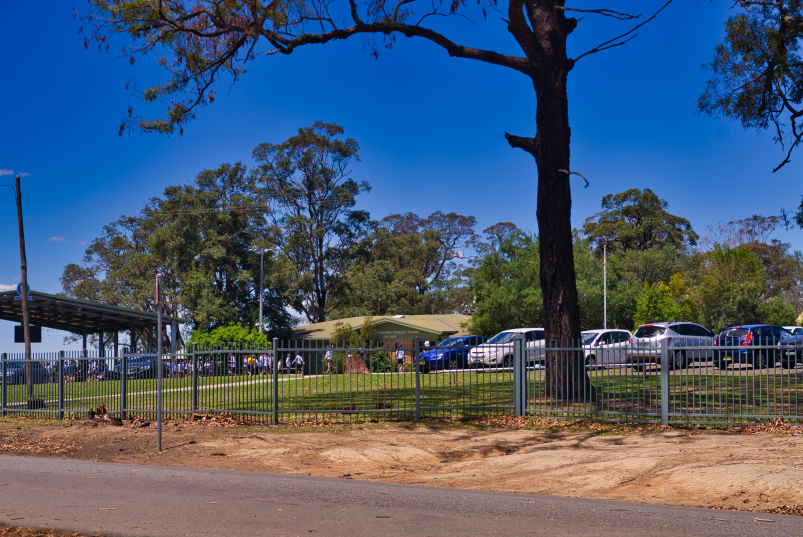
St Thomas Aquinas School from the access road looking north-east. Image: Tony McArthur
St Thomas Aquinas Primary School
At about 1:20 pm, smoke from the State Mine fire, which was burning north of Bell’s Line of Road to the north-west, was dense enough for staff to keep the Kindergarten, Year 1 and Year 2 children in the school hall. Upon receiving the call from St Columba’s College, the principal moved all students to the hall. A deliberate
effort was made to be factual with the children about the fire near the school. Class rolls were marked and rooms were searched. A headcount confirmed that all students, staff and visitors were present. Students were reassured by their teachers who remained with them; teachers were calm and professional. Seeing the smoke, some parents arrived to collect their children, which added to the situation’s complexity.
The fire was heard before it could be seen. At 2:00 pm, the principal rang Triple Zero reporting that there were 620 people in the hall, sheltering in-place. At this time, emergency service resources were stretched to the limit, so the principal was directed to inform the police as the school was not under direct threat. This second call resulted in a police car arriving. The principal was advised to either shelter in-place or to evacuate to the east, towards Whitecross Road and its shopping centre. He was assured that this was a safe option. The principal discussed the options with the assistant principal and they decided to evacuate on foot to the east.
At about 2:10 pm, the evacuation began with younger students leading the way followed by the older students, accompanied by their teachers, and finally the principal and office staff. The route was across the open grassy paddock on the eastern side of the school to Paulwood Avenue that led to Hawkesbury Road. Students and staff walked almost 3000 metres to the shopping mall on Whitecross Road, Winmalee (see Map 2), supervised by local police.
Once the students arrived, they assembled inside the shopping centre where many people, who had self- evacuated from the path of the fire, had gathered. Rolls were marked and children were released to parents who came to collect them. The police continued to provide the principal with good information and also organised buses to take the remaining children to an evacuation centre in Springwood where they were released to their parents.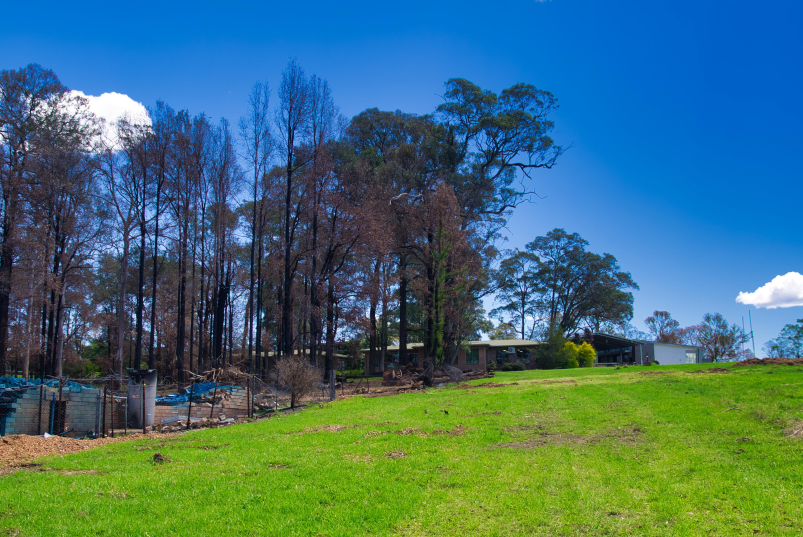
View of the back of St Thomas Aquinas School looking from the back of Paulwood Avenue. The students walked across this paddock to reach Paulwood Avenue. Note the house destroyed on the left and the burnt trees. Image: Tony McArthur
Discussion and observations
Following the fire, the acting principal of St Columba’s College and the principal of St Thomas Aquinas School were interviewed. The interviews and the experience of firefighters confirmed the aggressiveness of the Linksview fire. After the school was evacuated, the fire spotted across the access road and destroyed homes on the northern end of Paulwood Avenue. Had the evacuation of St Thomas Aquinas School been delayed, the evacuation route would have been blocked by fire (see Figure 2), potentially requiring the allocation of firefighting resources to protect the students and staff.
The importance of preparation of the site
The relationship between topography, climate and vegetation and the impacts these have on fire behaviour are well understood (Ellis, Kanowiski & Whelan 2004, Australian Government 2010, Blanchi, Leonard & Leicester 2011, Gill & Stephens 2009). Preparedness activities that mitigate the effects of disaster events are an effective means of reducing risks to life and property (Department of Education 2011, Catholic Education Commission of Victoria Ltd 2013, NSW Rural Fire Service 2012, O’Neill & Handmer 2012). St Columba’s College and St Thomas Aquinas School had been assessed as at ‘extreme’ risk of a fire, which is ‘almost certain’ to occur (Blue Mountains Bush Fire Management Committee 2008, p.30).
Both schools had completed work to assess their exposure and risk levels. St Columba’s College has stone buildings that have survived many fires since 1909 when the original buildings were constructed. The newest building was designed to be fire resistant; consistent with contemporary building codes. Older buildings had been renovated with attention to vulnerability to ember attack from fires. In addition, an asset protection zone had been established around the buildings. The timber buildings at St Thomas Aquinas School are less fire-resistant and this has been accounted for in the school’s maintenance and preparation works. The newest building, the school hall, was built to resist direct flame and ember attack.
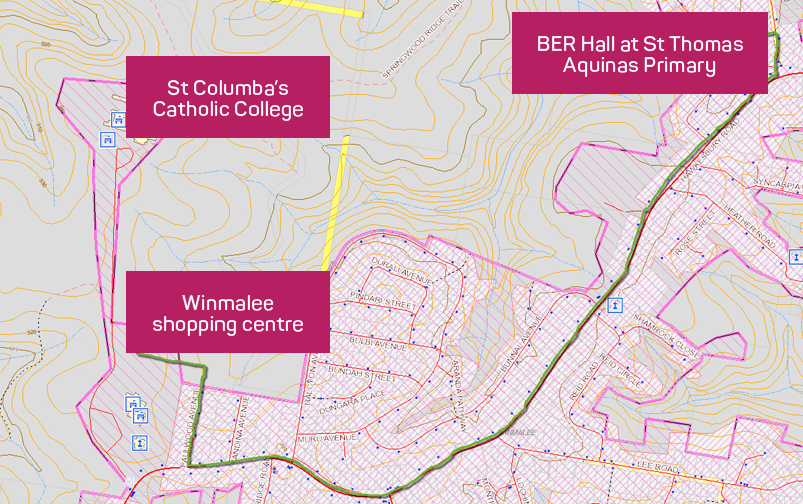
Figure 2: The evacuation route from St Thomas Aquinas School to Winmalee shopping mall.
Image: RFS ICON map with overlay
Facing the worst-case scenarios, planning and drills
Exposure of property and its occupants to hazards is specific to a site’s circumstances. While some hazards can be common to all sites, each site will have unique circumstances. For these schools, their circumstances included their vulnerability to bushfires coming from the west and that they have a single access road off Hawkesbury Road. In both cases, the principals considered the likely and possible issues that might arise and identified the ‘worst-case’ scenarios. The emergency response plans for both schools included evacuation routes, orders of the evacuation of spaces and classrooms, identifying key personnel and defining their rolls, marking off student attendance and considering the safety of visitors.
Their site-specific plans were tested using evacuation drills. Fire drills are common in schools and both schools had planned and rehearsed complete site evacuations to Hawkesbury Road. Both schools had plans for lockdowns and evacuations and both had planned to use Paulwood Avenue as an evacuation route. Few schools go to the trouble of disturbing teaching activities with large site evacuations and it is sometimes difficult to justify the effort emergency planning and drills require (Catholic Education Commission of Victoria Ltd 2013). Both schools had done drills to ensure students and staff were familiar with the procedures. Actual evacuations of large numbers of people should not be undertaken lightly (Sorensen, Shumpert & Vogt 2004, p.10).
Implementing the plans
Both schools could ably implement their lock-down procedures and the movement and safety of students. The role of the staff was key to ensuring safety and facilitating evacuation. The value of undertaking preparatory drills was reinforced when the emergency situation required the emergency plans to be implemented.
Communication with the community
Both schools made efforts to inform families of their bushfire emergency plans. St Columba’s College also has access to the SMS notification system of the Diocese of Parramatta, which they used to good effect.
Emergency services
Both principals acknowledged that, in an emergency, they could not expect to have access to significant emergency resources unless they were directly under threat. However, having the correct information from emergency services organisations helped them assess their risk and actions to take. In this case study, the principal of St Thomas Aquinas School believed he received sound advice from police and this enabled him to make a confident decision to evacuate in a timely fashion.
Decision-making
Decision-making in an emergency situation is seldom easy. Both the acting principal at St Columba’s College and the principal of St Thomas Aquinas School had participated in the Hawkesbury Road Project workshop, which focused on the nature of bushfire threats, capabilities of emergency services agencies and decision-making based on situational awareness. Both school leaders indicated that good decision-making depends on considering a range of possible scenarios. Both principals also had a good knowledge of the local area and access to credible information sufficient to help them to make decisions. For St Columba’s College, once the access road was cut, sheltering in-place under lockdown was the viable option. For St Thomas Aquinas School, the information provided by police and consultation with the leadership team supported their decision-making.
Support provided by education authorities
The school leaders were appreciative of the support provided by the Catholic Education Office, Diocese of Parramatta on the day of the fire and subsequently. The SMS notification system proved particularly important.
Equipment deficiencies
The loss of power was a particular difficulty for St Columba’s College. By the time the evacuation began, the school had been without power for four hours and the dependence on mobile phone communications drained batteries quickly. The school also lost water pressure and drinking water was not readily available. Since the fire, St Columba’s College has purchased bottled water that is stored on-site and replaced annually. Additionally, 2000 smoke masks have been purchased to address problems with smoke inhalation, particularly for asthma suffers.
Staff issues
Both school leaders identified that their staff may not have personal arrangements in place for occasions when they needed to be involved in lock-down situations or to supervise students during an evacuation. Staff needed to consider their own family arrangements for times when they are unable to undertake them due to their duties at school.
The role of students
In both schools, students had been prepared for the emergency through drills led by their teachers. While there is value in students understanding bushfire and other emergencies (Towers 2012, Towers et al. 2014), students depend on and seek direction and protection from their teachers (Pooley, Cohen & O’Connor 2010). Their trust in them was a significant factor in the successful response of the schools to the Linksview fire.
Training school leaders and preparing schools
There are two key issues facing emergency services organisations and school authorities when addressing bushfire threats: site preparation and educating school leaders. Site preparation is a component of school maintenance and capital works planning. As such, it is the responsibility of the authority that conducts the school.
Given Australian communities can be quite exposed to natural disasters, it is surprising that the Australian Professional Standards for Teachers makes no explicit mention of emergency management considerations (Australian Institute for Teaching and School Leadership Limited 2011). In that document, ‘Standard 4: Create and maintain supportive and safe learning environments, Focus area 4.4, Maintain student safety’, requires lead teachers to ‘Evaluate the effectiveness of student wellbeing policies and safe working practices using current school and/or system, curriculum and legislative requirements and assist colleagues to update their practices’. Training is being provided in all school sectors to prepare more school leaders for the emergency response role. To this end, the RFS has allocated resources of its staff and volunteers to provide support to schools.
Conclusion
The Linksview fire in 2013 had a terrible impact on the local community and it highlighted the problems facing communities if bushfires threaten schools when staff and students need protection or evacuation. In this case study, both schools came through the event without loss of life or significant property damage and were able to examine their actions to improve their planned response. The two schools, in some ways, experienced a best-case scenario. Their preparation enabled them to make good decisions on the day of the fire. The implication is clear: all schools in a bushfire-prone area should be specifically prepared by knowing their risks and response scenarios and school leaders should be trained to make decisions in the interest of their students, staff and the community.


